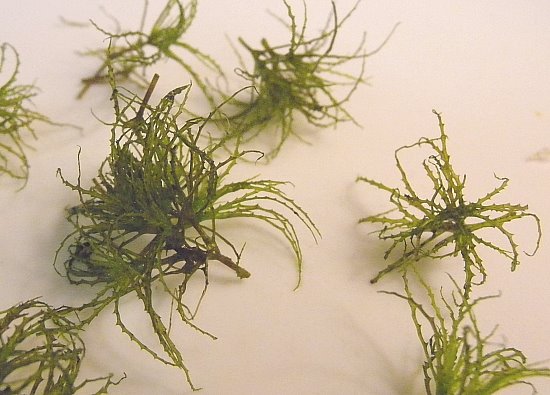
Mature plants are usually monoecious, rather than dioecious, producing sessile unisexual flowers in the axils of their leaves. These flowers are about 2 mm. long. Individual male (staminate) flowers consist of a single stamen, while individual female (pistillate) flowers consist of a single pistil. Both types of flowers are surrounded by a membranous spathe. The blooming period occurs from mid-summer into the fall. The female flowers are replaced by beaked fruits that are ellipsoid-oblongoid in shape, slightly curved, and about 1.5-3.0 mm. long. Each fruit contains a single seed that is a little shorter than the fruit. Individual seeds are longitudinally ribbed and faintly reticulate. The root system is shallow and fibrous. The fragile stems of older plants are easily broken, creating plant fragments that drift with their seeds in water currents to new locations.
Cultivation: The preference is full or partial sun, shallow to moderately deep water (up to 15' deep) that is clear to slightly turbid, and a water bottom containing sand, silt, or mud. Acceptable water pH varies from slightly acidic to alkaline. Brittle Naiad is more tolerant of water that is turbid and polluted than other Najas spp. (Naiads). It can spread aggressively.
Range & Habitat: The introduced Brittle Naiad (Najas minor) is occasional to common in the southern half of Illinois, while in the northern half of the state it is uncommon or absent. This plant has been introduced into eastern North America from Eurasia. In many areas of North America, it is considered an invasive species. Habitats include shallow water along lake shores, sheltered lake inlets, ponds, streams with slow currents, and drainage canals. Brittle Naiad is especially common in young ponds and other wetlands that have been created through human agency. It is also found in natural wetlands that have been degraded by siltation or pollution (e.g., fertilizer run-off and other chemicals).
Faunal Associations: The larvae of a shore fly, Hydrellia bilobifera, feed on the submerged leaves and stems of Naiads (Najas spp.); see Harms & Grodowitz (2009). Several species of waterfowl, especially ducks, feed on the foliage and seeds of these aquatic plants; this includes the American Wigeon, Mallard, Gadwall, Lesser Scaup, and Common Coot. The Waterfowl Table displays a more complete list of these species. Many turtles also reportedly feed on Naiads; this includes the Snapping Turtle (Chelydra serpentina), Painted Turtle (Chrysemys picta), Blanding's Turtle (Emys blandingii), River Cooter (Pseudemys concinna), Musk Turtle (Sternotherus odoratus), and Slider (Trachemys scripta); see Lagler (1943) and Ernst et al. (1994). The Muskrat feeds on these plants to a minor extent, as does a freshwater fish, the Bluegill (Lepomis macrochirus); see Hamerstrom & Blake (1939) and Forbes (1888). As an invasive species, Brittle Naiad (Najas minor) has been able to spread to new areas through such human-related activities as: 1) incorrect disposal of plants in aquariums, 2) transportation of plant fragments and seeds on fishing nets, and 3) transportation of plant fragments and seeds on boat trailers, propellers, hulls, and anchors. In addition, it is likely that the seeds of this plant are transported by wetland birds to new wetlands on their feathers or muddy feet; perhaps some of the seeds are also able to pass through the digestive tracts of these birds and remain viable. Colonies of Naiad plants provide good cover for minnows and other small aquatic wildlife.
Photographic Location: The plant fragments were found in a pond near Urbana, Illinois, although they were photographed indoors.

Comments: Immature plants of Brittle Naiad (Najas minor) are difficult to distinguish from the uncommon Thread-Leaf Naiad (Najas gracillima), although the appearance of mature plants for these two species are quite distinct. Mature plants of Brittle Naiad have leaves that are more wide (about 0.5-1.2 mm. across), more brittle, and a darker shade of green than those of Thread-Leaf Naiad; mature plants of Brittle Naiad also have leaves that are more recurved and their teeth are more conspicuous. Another species of this genus, Spiny Naiad (Najas marina), has even wider leaves (up to 2.5 mm. across) than Brittle Naiad and its leaves have teeth that are fewer in number, but larger in size. So far, Spiny Naiad has been found only in Lake County, Illinois, where it is probably adventive. Other common names of Najas minor include Brittle Water Nymph and European Naiad.